
Tibetan Buddhism is a form of Buddhism practiced in Tibet and Mongolia. It also has a sizable number of adherents in the areas surrounding the Himalayas, including the Indian regions of Ladakh, Sikkim, and Arunachal Pradesh, as well as Bhutan and Nepal. Smaller groups of practitioners can be found in Central Asia, Xinjiang, Inner Mongolia, and some regions of Russia, such as Tuva, Buryatia, and Kalmykia.
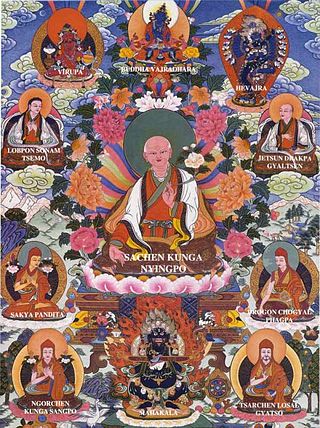
The Sakya school is one of four major schools of Tibetan Buddhism, the others being the Nyingma, Kagyu, and Gelug. It is one of the Red Hat Orders along with the Nyingma and Kagyu.

The Gelug is the newest of the four major schools of Tibetan Buddhism. It was founded by Je Tsongkhapa (1357–1419), a Tibetan philosopher, tantric yogi and lama and further expanded and developed by his disciples.
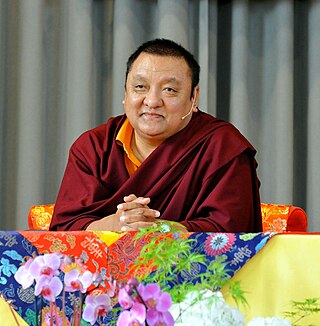
The Shamarpa, also known as Shamar Rinpoche, or more formally Künzig Shamar Rinpoche, is the second oldest lineage of tulkus. He is one of the highest lineage holders of the Karma Kagyu school of Tibetan Buddhism and is regarded as the mind manifestation of Amitābha. He is traditionally associated with Yangpachen Monastery near Lhasa.

The Rimé movement is a movement or tendency in Tibetan Buddhism which promotes non-sectarianism and universalism. Teachers from all branches of Tibetan Buddhism – Sakya, Kagyu, Nyingma, Jonang, Gelug, and Bon – have been involved in the promoting Rimé ideals.

Nyingma, often referred to as Ngangyur, is the oldest of the four major schools of Tibetan Buddhism. The Nyingma school is founded on the first lineages and translations of Buddhist scriptures from Sanskrit into Tibetan in the eighth century, during the reign of King Trisong Detsen.

Jamgön Kongtrül Lodrö Thayé, also known as Jamgön Kongtrül the Great, was a Tibetan Buddhist scholar, poet, artist, physician, tertön and polymath. He was one of the most prominent Tibetan Buddhists of the 19th century and he is credited as one of the founders of the Rimé movement (non-sectarian), compiling what is known as the "Five Great Treasuries". He achieved great renown as a scholar and writer, especially among the Nyingma and Kagyu lineages and composed over 90 volumes of Buddhist writing, including his magnum opus, The Treasury of Knowledge.

Jamyang Khyentse Wangpo, also known by his tertön title, Pema Ösel Dongak Lingpa, was a renowned teacher, scholar and tertön of 19th-century Tibet. He was a leading figure in the Rimé movement.
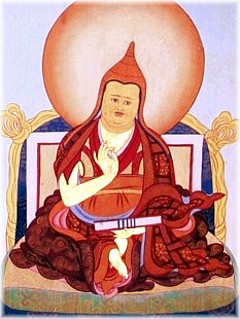
Jamgön Ju Mipham Gyatso, or Mipham Jamyang Namgyal Gyamtso (1846–1912) was a very influential philosopher and polymath of the Nyingma school of Tibetan Buddhism. He wrote over 32 volumes on topics such as painting, poetics, sculpture, alchemy, medicine, logic, philosophy and tantra. Mipham's works are still central to the scholastic curriculum in Nyingma monasteries today. Mipham is also considered one of the leading figures in the Rimé (non-sectarian) movement in Tibet.
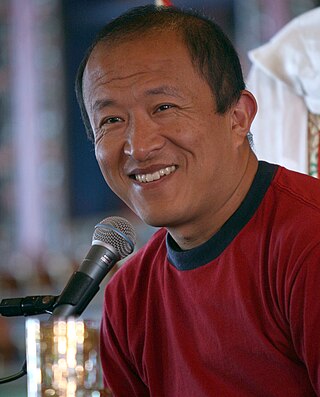
Dzongsar Jamyang Khyentse Rinpoche, also known as Khyentse Norbu, is a Tibetan/Bhutanese lama, filmmaker, and writer. His four major films are The Cup (1999), Travellers and Magicians (2003), Vara: A Blessing (2013), and Hema Hema: Sing Me a Song While I Wait (2017). He is the author of What Makes You Not a Buddhist (2007) and many other non-fiction works about Tibetan Buddhism.

Dzongsar Khyentse Chökyi Lodrö was a Tibetan lama, a master of many lineages, and a teacher of many of the major figures in 20th-century Tibetan Buddhism. Though he died in 1959 in Sikkim, and is not so well known in the West; he was a major proponent of the Rimé movement within Tibetan Buddhism, and had a profound influence on many of the Tibetan lamas teaching today.

Pabongkhapa Déchen Nyingpo, (1878–1941) was a Gelug lama of the modern era of Tibetan Buddhism. He attained his Geshe degree at Sera Mey Monastic University, Lhasa, and became a highly influential teacher in Tibet. He was unusual for teaching a great number of lay-people. Pabongkha was offered the regency of the present Dalai Lama but declined the request because "he strongly disliked political affairs."

Katok Monastery, also transliterated as Kathok or Kathog Monastery, was founded in 1159 and is one of the "Six Mother Monasteries" in Tibet of the Nyingma school of Tibetan Buddhism, built after Samye Monastery. It is located in Payul, Karze Prefecture, Sichuan, China, known as Kham.
The Jamyang Zhepas are a lineage of tulkus of the Gelug school of Tibetan Buddhism. They have traditionally been the most prestigious teachers at Labrang Monastery in Amdo, Tibet.
The Second Beru Khyentse (1947–), born Thupten Sherap is a lineage holder of the Karma Kagyu school of Tibetan Buddhism and the third reincarnation of Jamyang Khyentse Wangpo (1820–1892).

Dzongsar Monastery is a Buddhist monastery in Dêgê County in the Garzê Tibetan Autonomous Prefecture of Sichuan, China, southeast of the town of Derge and east of Palpung Monastery. Historically it lay in the Kham region of Tibet. It was founded in 746, destroyed in 1958, and rebuilt in 1983.
Ngor is a sub-sect of the Sakya tradition of Tibetan Buddhism. The main monastery of the Ngor sect is the Ngor monastery of Evam Choden about 20 kilometres (12 mi) southwest of Xigazê.

Ratna Vajra Rinpoche, is a Tibetan Buddhist teacher who served as the 42nd Sakya Trizin from 2017 to 2022, considered one of the highest qualified lineage masters of both the esoteric and exoteric traditions of Buddhist philosophy and meditation. He is a descendant of the famous Khon family in Tibet, which holds an unbroken lineage of great and famous masters for over a thousand years. He is the eldest son of the 41st Sakya Trizin Ngawang Kunga. He teaches Buddhism and travels extensively throughout Europe, Asia, Australia, New Zealand and North America. Ratna Vajra was enthroned as the head of the Sakya school on 9 March 2017. On 16 March 2022, the throne of the Sakya school was passed by Ratna Vajra to his younger brother Gyana Vajra, who became the 43rd Sakya Trizin.

The Tibet Center, also known as Kunkhyab Thardo Ling, is a dharma center for the study of Tibetan Buddhism. Founded by Venerable Khyongla Rato Rinpoche in 1975, it is one of the oldest Tibetan Buddhist centers in New York City. The current director is Khen Rinpoche Nicholas Vreeland, the abbot of Rato Dratsang monastery. Philip Glass assisted with the founding of The Tibet Center. Since 1991 TTC has invited and hosted the 14th Dalai Lama for teaching events in New York in partnership with the Gere Foundation.
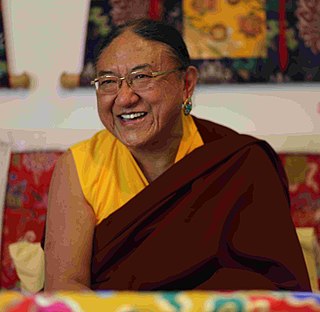
Sakya Trizin Ngawang Kunga served as the 41st Sakya Trizin, the throne holder of the Sakya Lineage of Tibetan Buddhism, from his appointment in 1952 until his retirement in 2017. His religious name is Ngawang Kunga Tegchen Palbar Trinley Samphel Wangyi Gyalpo. After passing the throne of the Sakya lineage to his elder son Ratna Vajra Rinpoche who became the 42nd Sakya Trizin on 9 March 2017, he is now known as Kyabgon Gongma Trichen Rinpoche. He is considered second only to the Dalai Lama, in the spiritual hierarchy of Tibetan Buddhism.





















